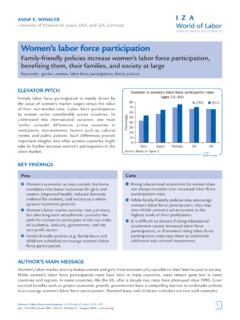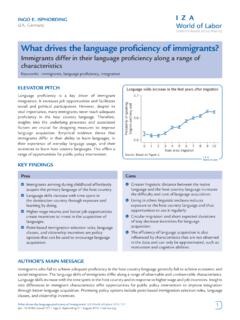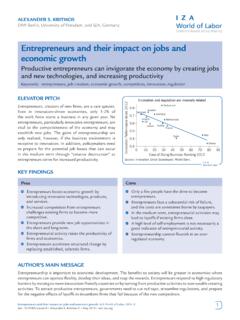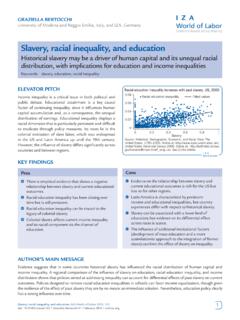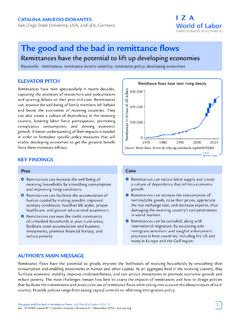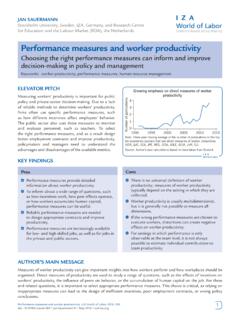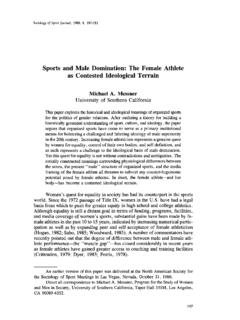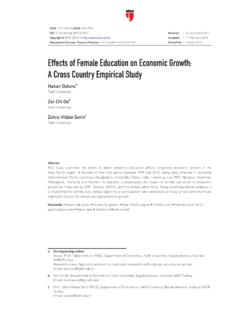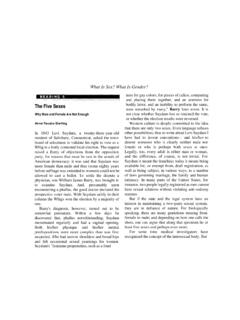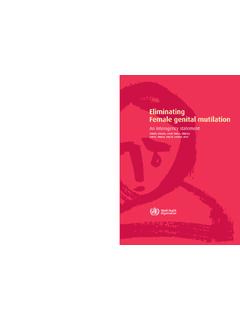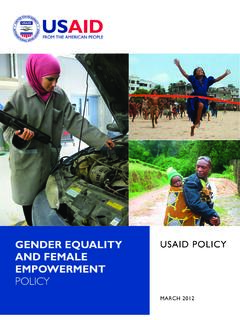Transcription of Female education and its impact on fertility
1 Jungho KimAjou University, Republic of Korea, and IZA, GermanyFemale education and its impact on fertility . IZA World of Labor 2016: 228doi: | Jungho Kim | February 2016 | Pros The fertility gap between women with primary vs no education widens as incomes increase, but decreases at higher (secondary vs primary) education levels. Educated women are more physically capable of giving birth than uneducated women; but want fewer children and control birth better. Educated women provide better care at home, thus increasing the value of their children s human capital and reducing the need for more children. At relatively early stages of a country s development, educated women adopt modern birth control methods more often than uneducated PiTChThe negative correlation between women s education and fertility is strongly observed across regions and time; however, its interpretation is unclear.
2 Women s education level could affect fertility through its impact on women s health and their physical capacity to give birth, children s health, the number of children desired, and women s ability to control birth and knowledge of different birth control methods. Each of these mechanisms depends on the individual, institutional, and country circumstances experienced. Their relative importance may change along a country s economic development The negative correlation between Female schooling and fertility is strong but not the same across countries; it varies at different levels of women s education and stages of a country s development. Each factor affecting fertility works in certain settings, but the relative importance of each one is unknown.
3 Parents ability to generate wealth may be transferred to their children through investment in children s human capital. It is unclear whether education increases women s access to new information or their ability to adopt new birth control education and its impact on fertilityThe relationship is more complex than one may thinkKeywords: Female education , fertility , demand for children, fertility control costs, returns to education , family planningKEY FinDingSAuThoR S mAin mESSAgEThree mechanisms influence the fertility decision of educated women: (1) the relatively higher incomes and thus higher income forgone due to childbearing leads them to want fewer children. The better care these women give increases their children s human capital and reduces the economic need for more children; (2) the positive health impacts of education , on both women and their children, mean women are better able to give birth and children s higher survival rate reduces the desire for more; and (3) the knowledge impact of education means women are better at using contraceptives.
4 For developing population policies, it is thus important to understand these impacts on income, health, and knowledge, and their influence on fertility decisions in the specific country schooling and fertility , 2010 (selected countries)Source: Author s own calculations based on Barro and Lee (2010) and World Development fertility rate0510 Completed years of schooling for women of reproductive age150 IZA World of Labor | February 2016 | Kim | Female education and its impact on fertility moTi VATionEducated women generally have fewer children than uneducated women. This negative relationship is strong and varies across both developed and developing countries (measured by GDP per capita) and among women of different education levels. This is not surprising, since countries differ in their various institutional aspects, including education quality.
5 Further, different education levels can generate different kinds of incentives. For example, better-educated women tend to have better jobs and earn higher incomes, thus the forgone earnings from taking care of children would be higher for these women. Thus, women with primary education tend to have 0 30% fewer children than uneducated women (ratio of total fertility rate of 1 to ). The differential, if any, tends to widen as income increases. Further, women with secondary education tend to have 10 50% fewer children than those with primary education (ratio of total fertility rate of to ), with gaps narrowing as income increases (Figure 1). It would be useful for policymakers to understand the mechanisms through which Female education affects fertility in the contexts in which these outcomes are 1.
6 Women s total fertility rates decrease at increasing levels of incomeNote: The total fertility rate (TFR) ratio is the TFR of the more-educated women, in each panel, divided by that of theless-educated women. The lower the TFR, the stronger the correlation between women s education and fertility . Dataare taken from 221 surveys over 75 countries between 1985 and : Author s own calculations, based on data from: USAID STAT compiler, 2015. Online at: of total fertility per capita (constant 2005 US$) vs no educationSecondary vs primaryeducationDiSCuSS ion o F PRoS AnD ConSWhat is the causal effect of education on fertility ?In principle, women who attend school may have different ideas on family size than those who do not attend school. Hence, economists have questioned whether the observed correlation between women s education and fertility is causal.
7 The illustration on p. 1 shows that countries with a higher share of better-educated women tend to have lower fertility rates. However, even at similar levels of schooling, fertility rates differ across countries, suggesting that other factors might also influence World of Labor | February 2016 | Kim | Female education and its impact on fertility Researchers have observed women s access to education in order to determine whether this has an impact on fertility . A US study compared areas by number of colleges present, and found that Female college graduates have 20% fewer children, on average, than high-school graduates [1]. In contrast, another study examined women born before and immediately after the school entry date, in the US, concluding that education does not have a significant impact on fertility [2].
8 These different results may be because researchers investigated different populations, in different regions and time periods. The former examined a sample of child births between 1970 and 1999, whereas the latter dealt with a sample between 1989 and 2002. More importantly, the former focused on women who would be expected to change their decision to go to college, depending on the availability of colleges close by, whereas the latter analyzed women whose educational outcomes would potentially be affected by school entry changes in legislation also offer a chance to verify the causal effect of women s education on fertility . Between 1960 and 1972 the Norwegian government implemented an educational reform that extended compulsory schooling from seven to nine years.
9 This reform was gradually introduced, with each municipality deciding when to adopt it. One study compared Female students who were born in the same year but in areas that differed by reform status [3]. It found that the reform increased Female schooling by an average of years. However, total fertility did not change, possibly because Norwegian women already tended to postpone childbearing until their 20s or offers another example of the education fertility nexus. In 1948, Israel s military government placed a restriction on its Arab population traveling within the country. In 1963, it lifted the restriction due to growing public opinion in favor of democracy. Arab children could freely move across localities to attend school if there was no school nearby.
10 Observing the same areas before and after the change revealed that Arab girls schooling increased by one year and their fertility declined by children, on average, after the travel restriction was removed [4].A school construction program that took place in Indonesia between 1973 and 1978 provides an example for a developing country. One study found that an increase in women s education by one year, compared to their husband s education level, reduced their fertility at age 25, by children, on average [5]. A study on Nigeria investigated a universal primary education program that took place between 1976 and 1981, and found that it also influenced fertility behavior [6]. Accordingly, women with an additional year of schooling had, on average, fewer children before age 25 than they would otherwise have had.
